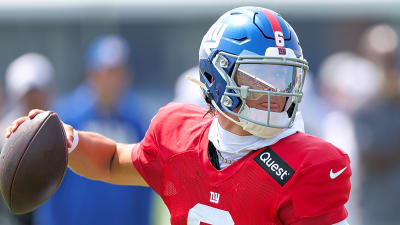
Fantasy Football rookies to watch (and worry about) in 2025
The excitement around rookies always spirals during every fantasy season. You might target someone as a sleeper in the 10th round, but by the time your draft rolls around, he’s being picked in the sixth. Occasionally, this strategy pays off, but more often than not, it doesn’t.
We lined up season-long format ADP with projections from Sean Koerner and Chris Raybon. Some of these rookies look like league winners. Others are more likely to wreck your season.
Don't forget to sign up for your fantasy football league on Yahoo Sports!
Use promo code YARD20 for $20 off your FantasyLabs fantasy football subscription!

Rookies Who Could Pop
Ashton Jeanty – RB, Las Vegas Raiders
It’s no surprise to see Ashton Jeanty included here. After putting together one of the best college football campaigns ever—posting 2,601 yards and 29 touchdowns at Boise State—the Raiders made him the sixth overall pick, and he’s already being drafted in the first round of fantasy leagues. Even as a rookie, there’s a lot to be excited about.
Jeanty brings an immediate impact skillset. He combines powerful running with pass-catching ability, and he’s expected to have the Las Vegas backfield to himself. With Geno Smith at quarterback and one of the league’s weakest receiving corps, the offense is built around him.
His upside can’t be ignored. He finished second in Heisman voting, he’s already being ranked as a top-five fantasy running back, and there’s really no competition for touches in Vegas. As long as he stays healthy, Jeanty should be among the league leaders in workload as a rookie. There’s no need to overcomplicate things here—our experts believe the hype is well deserved, even with the Raiders.
Tetairoa McMillan – WR, Carolina Panthers
Tetairoa McMillan arrives in the league with impressive credentials. He was the first wide receiver selected in a draft class without a consensus WR1, going eighth overall to Carolina. He was a standout at Arizona, surpassing 1,300 yards and drawing over 130 targets in his final year. Even when defenses knew he was the focal point, he continued to produce.
There are some concerns about how his skills will transfer to the pros, particularly regarding his ability to separate. McMillan isn’t especially sharp as a route runner, but his size and reach allow him to excel in contested situations. He does his best work over the middle of the field, which meshes well with Bryce Young’s strengths. Young relies on short and intermediate throws, which is right where McMillan operated in college.
Right now, his ADP puts him ahead of some more proven receivers like Xavier Worthy, DJ Moore, and DeVonta Smith. That feels a bit aggressive given the usual uncertainty that surrounds rookie wideouts. Carolina was 23rd in scoring last season, so there’s no assurance the offense will make major strides. However, McMillan is more appealing in full-PPR leagues—he’s available later in those formats and projects as a reliable volume WR3.
There’s definitely some risk, but he has plenty of upside too. McMillan joins a receiver group where he should see very little competition for targets. If you want to draft for potential in PPR formats, there’s a legitimate case to make for him. Just don’t expect big box-score numbers right away—if that’s your goal, you might want to consider other options.
Tyler Warren – TE, Indianapolis Colts
Tyler Warren is currently being drafted around TE10, placing him squarely in the middle of the late-round dart throw group. He’s coming off the board just ahead of Colston Loveland, Dalton Kincaid, and Jonnu Smith, but still trails established veterans like Mark Andrews, Evan Engram, and David Njoku—a gap that could close quickly.
The Colts have struggled at tight end for years, ranking near the bottom of the league in targets, receptions, and fantasy production from the position since 2020. Warren steps into an ideal opportunity where he could start immediately, paired with a quarterback—whether Anthony Richardson or Daniel Jones—who favors short-area passes.
At Penn State, Warren broke out in his final season with over 1,200 yards and 8 touchdowns. He offers versatility, lining up in the slot, in-line, or even in the backfield. Under Shane Steichen’s play calling, Warren has a path to steady volume regardless of how well the offense performs.
The investment to draft him is minimal, and if he reaches 70+ targets—which is well within his range of outcomes—he could easily finish inside the top eight by season’s end. For those punting the tight end position, Warren stands out as a strong rookie fallback option.
Dominate your Best Ball and season-long fantasy football leagues with FantasyLabs’ brand-new app that's available in the Apple App Store and on Android!

Rookies Who Could Flop
Cam Ward - QB, Tennessee Titans
Cam Ward may have been the No. 1 overall pick, but that doesn’t guarantee he’ll be an immediate asset for your fantasy roster. He’s currently being drafted as QB22—going before proven veterans like Matthew Stafford and Geno Smith—which feels a bit premature. Koerner ranks Ward as the QB25, while Raybon has him at QB26. The Titans had one of the league’s worst offenses last season, and Ward now finds himself in a similar environment, learning a new system with a less-than-stellar group of weapons.
Ward showed flashes of potential in college, finishing top five in both yards per attempt and big-time throw rate. However, he also ranked outside the top 30 in clean-pocket accuracy and had issues when facing pressure. While Tennessee’s offensive line could be better this year, it still isn’t a sure thing, and there isn’t a clear go-to target in the receiving corps. Calvin Ridley and Tyler Lockett aren’t getting any younger—together, they’re pushing 140 years old.
Ward might have a few big fantasy outings, but touchdowns could be too inconsistent for him to justify his current draft spot. The Titans enter 2025 with just the 28th-ranked implied point total, which limits Ward’s upside. He’s best reserved for Superflex and 2QB formats. In standard 1QB leagues, streaming the position is probably the smarter play.
Emeka Egbuka – WR, Tampa Bay Buccaneers
Emeka Egbuka is being drafted around WR48, but Koerner ranks him at WR59—a gap that suggests expectations may be running ahead of reality. He’s turned heads in camp and boasts a strong college résumé, but his short-term path to steady fantasy production is unclear. Tampa Bay’s receiver room is deep, and as a rookie, he may spend much of the season behind established veterans.
At Ohio State, Egbuka played almost exclusively in the slot, which is also where the Bucs have primarily lined him up. The challenge is that Chris Godwin already holds that role. While Godwin is coming back from injury, unless he misses time or moves outside more frequently, Egbuka’s target volume in redraft leagues will likely remain limited. He’s been working both at the Z and in the slot, but with Jalen McMillan also competing for snaps, the situation becomes even murkier.
Egbuka’s polish and football IQ make him an appealing long-term investment, and he’s impressed in OTAs and minicamp. Still, even with strong scouting praise, his 2025 upside might be confined to Best Ball spike weeks or filling in when injuries strike. Right now, it feels like he’s being drafted more on talent and pedigree than on immediate opportunity.
There’s late-round stash appeal—particularly in full PPR—but fantasy managers hoping for an Amon-Ra St. Brown–style rookie breakout may be in for a letdown. Without a shake-up in the depth chart, Egbuka projects as a bench piece who could be cycled on and off rosters during the season. His breakout chances are real, but they may not arrive until after this fall.
Travis Hunter – WR, Jacksonville Jaguars
Travis Hunter is currently going off draft boards as WR29, though Koerner ranks him four spots lower at WR33. While that may not seem like a significant difference, it’s notable for a rookie who’s taking snaps on both sides of the ball. Hunter is a remarkable athlete and brings plenty of excitement, but he’s still refining his skills as a wide receiver, making it risky to count on instant efficiency.
The outlook for his usage seems promising, but the actual results might not match expectations. Even with a projected 80% snap rate, it’s hard to predict how much volume he’ll see from week to week. Brian Thomas Jr. could easily emerge as the offense’s top target, and Jacksonville’s passing game has always carried some question marks. Hunter may end up needing touchdowns to be fantasy-relevant, a category that’s tough to bank on.
Hunter’s flashes in college—when he ran a complete route tree—were impressive, with nearly 20 PPR points averaged in those situations. Still, the opportunities were limited, and his primary responsibilities were on defense. The step up to the NFL brings tougher challenges in route running, timing, and battling at the line, even for outstanding college athletes.
Long-term, there’s a lot to get excited about, but his redraft stock comes with volatility. If he’s asked to handle a heavy role on the outside right away, his inexperience might become apparent early on. He’s certainly worth a pick, but WR29 could be a bit steep for someone with so much unpredictability. Don’t be surprised if he gets off to a slow start as he adapts to the pro level.
More must-reads:
- 25 fantasy football sleepers you should target at your draft
- ESPN fantasy expert says these players could be 2025 NFL breakout stars
- The '2024-25 NFL passing-yard leaders' quiz
Breaking News
Trending News
Customize Your Newsletter
 +
+
Get the latest news and rumors, customized to your favorite sports and teams. Emailed daily. Always free!








